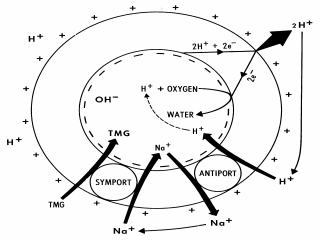| front |1 |2 |3 |4 |5 |6 |7 |8 |9 |10 |11 |review |
 |
Figure 7. Sodium-coupled accumulation. As will be covered in Professor Wright’s lectures, most eucaryotic plasma membrane symporters translocate substrate with sodium, and the enegetics of sodium coupled transport is precisely the same as that described for proton coupled symport (i.e., there is an electrical component and a chemical gradient of sodium that act as the total driving force, the electrochemical sodium gradient). Although most ion-coupled transporters in E. coli utilize protons as the symported ion, in some cases, sodium is used.
One bacterial ion-coupled symporter that uses sodium as the symported cation
is the melibiose permease when the non-metabolized analogue
thiomethylgalactoside (TMG) is the substrate. As always, protons are pumped
out via the respiratory chain (upper right) or the F1Fo-ATP
synthase (not shown), generating a
|